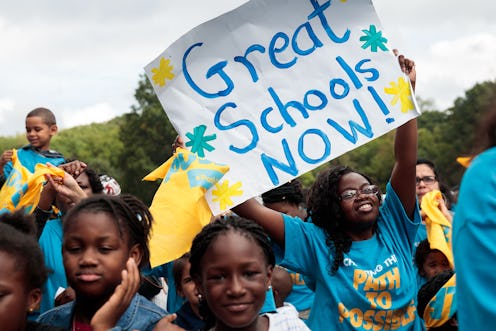Life
Gentrification Is Making Schools Less Segregated In D.C., According To A New Study

You may have heard about gentrification when discussing how trendy cupcake shops take over mom-and-pop shops that have come to define a neighborhood, but gentrification doesn't only change the food options in an area. Critics point out that gentrification often changes the racial make-up of a neighborhood, too, but a new study found that gentrification can actually increase school diversity when researchers examined Washington, D.C.’s public school system. These findings are counter to the popular narrative that gentrification ultimately decreases neighborhood diversity.
“Gentrification is a growing phenomenon that influences neighborhoods, cities and schools,” Kfir Mordechay, one of the co-authors of the study, which was published by the Civil Rights Project at University of California Los Angeles (UCLA), said in a press release. “It presents both challenges and opportunities. Smart policies and thoughtful leadership can manage neighborhood changes in ways that could potentially keep communities affordable, inclusive, dynamic, and diverse.”
Gentrification is generally defined as "the process of renovating and improving a house or district so that it conforms to middle-class taste." For the purposes of the study, researchers defined it as “changes in the proportion of white residents."
The study examined 11 census tracts that experienced at least a 25 percent increase in white residents between 2000 and 2015. Researchers looked a 67 schools within one mile of the center of selected census tracts and compared school demographic data for the years 2000, 2007, and 2014.
Many white parents are still opting to enroll their child in private schools, but public schools are preferred over charter schools, according to this study. The neighborhoods that were gentrifying at the fastest rates saw a decrease in segregation in traditional public schools. Between 2007 and 2014, the share of hypersegregated public schools (99 percent non-white students enrolled) in gentrifying areas fell from 67 percent to 41 percent. Research shows that racially and socioeconomically diverse schools provide cognitive (higher average test scores, lower drop out rates) and social (reduction in racial bias) benefits to all students.
Charter schools, however, didn't see the same increased diversity as traditional public schools. The majority of all charter schools — independent schools that are run using public funds — in both gentrifying and non-gentrifying neighborhoods are still majority Black. In 2014, nearly three-fourths of charter schools were hypersegregated, while 54 percent of public schools enrolled 99 percent non-white students. This finding conflicts with previous research that found charter schools were a tool used by gentrifying, white families to avoid the public school system.
“Although we are concerned about the overall high levels of school segregation in Washington, DC, the trend toward declining racial segregation in gentrifying areas is encouraging,” Jennifer Ayscue, the other co-author of the study, said in a press release. “Our hope is that schools will continue to become increasingly integrated as neighborhoods grow more diverse.”
While increased diversity is good for Black, Asian, Latinx, and white children alike, other policies must be in place to make sure the Black children aren’t pushed out once they become adults. According to Dr. Gary Orfield, co-director of the Civil Rights Project, it's not wise to let gentrification run its course without intervention. "You have to have housing policies that enable people to stay [in their communities]."
Other policy recommendations from researchers include affordable housing and residential assistance programs at the federal and municipal levels and magnet programs in public schools to attract more parents to the D.C. public school system.
Miguel de Oliver, the author of a paper published in Urban Studies has another perspective on gentrification in D.C. "A lot of these neighborhoods are selling cultural diversity," he said, which is a term that's used to attract the upper-middle class to environments flavored with "minority aesthetics which contrast with suburbia,” according to de Oliver.
Gentrification is a multi-faceted public policy issue. And like most things, it can have positive and negative side effects. Further research needs to be done in other cities to determine if this study’s finding are an outlier or indicative of a larger pattern in demographic change.